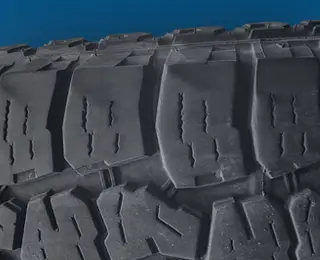You have already added that item to your appointment.

You have already added that item to your appointment.
Sometimes, the simplest description is the best. When it comes to tire cupping, that’s certainly true. Tire cupping looks like irregular dips or cups along the edge of the tire. When cupping on a tire happens, it’s often because the tires were not rotated every 5,000 miles. It can also be an issue with the alignment, shocks, struts or other parts of the suspension. Let’s take a look at what causes tire cupping, how it can affect your overall performance and vehicle safety, and what to do to avoid it.
Cupping or small dips on the edge of the tread are hard to miss. While it might not seem possible, those small valleys on your tires can cause all kinds of safety issues. It can also cost you more money. That’s because as tires wear down unevenly, they need to be replaced sooner than expected. That irregular tire wear can cause a rougher ride, longer stopping distances, and noises while driving. Other irregular tire wear patterns include diagonal or patchy wear, feathering, excessive center wear, as well as sidewall bulges and tire chunking.

Tire cupping, seen on the right, can cause performance issues.
In some cases, tire cupping is simply caused when tires aren’t rotated regularly. Les Schwab recommends you rotate your tires every 5,000 miles to get the most out of your investment. Other possible causes include worn or bent suspension parts, alignment issues (camber, caster, or toe settings), tire and wheel assemblies that need rebalancing, or incorrect tire pressure.
Here's a closer look at possible causes:
Aside from the visual indicators, including cupping along the edge of the tire, there are some warning signs. These include:
When you notice tire cupping, get to Les Schwab. Our professionals know what to look for and can offer recommendations to get you safely back on the road. This might be something as simple as a tire rotation or vehicle alignment. When they need to be replaced, you’ll find the tires you need backed by America’s Best Tire Warranty at Les Schwab.
The tread on your tires is designed to keep uniform contact with the road. This area where the tread and road meet is called the contact patch. The bigger the contact patch, the better your vehicle will perform, as well as stop when needed. When that contact patch is compromised with cupping and other irregular wear, it can lead to noises, vibrations, loss of control, and less-than-stellar stopping. Plus, it can cost you money when you have to buy tires too soon or parts of your vehicle need repairs or replacement.
When irregular wear and tire cupping starts, it can be very difficult or impossible to fix. To help avoid tire cupping and save yourself some money, try these tips:
Regular checks of your vehicle’s alignment, suspension, tires, wheels, battery, and brakes can help save you money and ensure your tires last as long as possible. Schedule your free pre-trip safety check at Les Schwab today. We’ll check your tires for cupping and visually inspect some of your vehicle’s most important parts.